
Jaime Grutzendler
@JGrutzendler
Followers
1K
Following
363
Media
6
Statuses
173
Neuroscientist and Neurologist @Yale / Cellular Mechanisms of Neurodegeneration / Glial-Vascular Biology / Translational Neuroscience / Intravital Microscopy
New Haven, CT
Joined June 2020
thank you Alzforum for a clear and comprehensive commentary on our recent subcellular antibody based human brain proximity- based proteomics in Alzheimer disease
Subcellular proteomics reveals how #alzheimersdisease affects the myelin-axon interface. Spoiler alert: AD promotes aberrant signaling that likely dampens synaptic transmission. @Yale
1
1
14
5/ We thank collaborators Angus C. Nairn, @e_petsalaki and Jüri Reimand and all other coauthors for their invaluable contributions and our generous funders: NIH, Cure Alzheimer Fund, BrightFocus Foundation, Alzheimer’s Association and Yale ADRC.
0
0
4
4/Quantitative imaging and expansion microscopy reveal reduced paranode density, paranodal enlargement, and prominent amyloid‑β spirals within paranodal and myelin channels, often accompanied by axonal swelling—changes predicted to impair signal propagation.
1
0
1
3/ We revealed that AD disrupts the paranodal axon–myelin interface, but not bulk myelin. Altered proteins map to lipid metabolism, Ca²⁺ signaling, GPCRs, ferroptosis & axonogenesis—these could weaken axonal metabolic support & signal fidelity.
1
0
1
2/ Led by postdoc @YifeiCai_ , we applied subcellular proteomics, expansion microscopy + AI 3‑D histology in human and mouse cortex, and re‑analysed recent scRNA‑seq/proteomes.
1
0
0
1/ I am happy to share our latest publication in Nature Neuro https://t.co/QCdfr2RRf8. We present the first subcellular proteomic atlas of the myelin–axon interface in human and mouse brain, revealing extensive Alzheimer‑related abnormalities.
6
15
79
4/ Quantitative imaging and expansion microscopy reveal reduced paranode density, paranodal enlargement, and prominent amyloid‑β spirals within paranodal and myelin channels, often accompanied by axonal swelling—changes predicted to impair signal propagation.
0
0
0
3/ Led by @YifeiCai , we used antibody‑guided proximity biotinylation, expansion microscopy and AI‑assisted histology. Combined with re‑analysis of scRNAseq and bulk myelin proteomes showed no reduction in total myelin in AD versus age‑matched controls.
1
0
1
2/ Axons transmit electrical impulses but rely on a fatty myelin sheath—much like insulation on a cable—for speed and metabolic support. We asked whether Alzheimer’s disease (AD) causes global myelin loss or more localized disruption at the axo‑myelin junction.
1
0
0
4/ Grateful to our collaborators Angus Nairn, Kristen Brennand (@kristenbrennand), Evangelia Petsalaki (@e_petsalaki), and all our coauthors for their contributions! #Alzheimers #Neuroscience #Proteomics #Neurodegeneration
0
0
4
3/ We also optimized an iPSC-derived AD model that develops spheroids strikingly similar to human brains. Inhibiting mTOR reduced PAAS pathology, suggesting some axonal changes may be reversible.
1
0
3
2/ Using our proximity labeling approach, we created a molecular map of PAASs in human & mouse brains. We found abnormalities in protein turnover, cytoskeleton, & lipid transport, all regulated by the PI3K/AKT/mTOR pathway.
1
0
2
1/ Plaque-associated axonal spheroids (PAASs), or dystrophic neurites, form in hundreds of axons around each amyloid plaque in AD. We previously showed they block action potential conduction & disrupt neural circuits ( https://t.co/d45YU6lesB).
nature.com
Nature - Amyloid-plaque-associated axonal spheroids are prominent contributors to neural network dysfunction in an Alzheimer’s model and can be reversed by endolysosomal modulation.
1
0
2
🧵 New from our lab! Led by outstanding research scientist @YifeiCai_, we optimized Antibody-Driven Proximity Labeling for postmortem tissues, enabling precise subcellular proteomic analysis of axonal spheroids in Alzheimer’s human brain.
nature.com
Nature Aging - Axonal spheroids disrupt neural circuits in Alzheimer’s disease. In this study, using subcellular proximity labeling proteomics in human brain and iPSC modeling, the authors...
3
10
66
New work from Yasmine Kamen shows that differentiating oligodendrocytes are filled with the zymogen procaspase-3. This provides a specific marker for new oligodendrocytes and suggests a role for this pathway in oligodendrocyte fate decisions. https://t.co/qGx23d7Dxp
1
24
130
Super-excited to reveal our latest fluorescent voltage indicator, ASAP5, now online @NeuroCellPress! ASAP5 features higher responsivity and kinetics, allowing detection of single synaptic transmission events. The link gives free access until 2024.11.09: https://t.co/9GSeEyq0Fi
9
93
370
Cerebrospinal fluid links the brain and peripheral sensory system and drives headache in migraine with aura! We’re excited to share our newest article just published today in @ScienceMagazine . Please read along: https://t.co/ab3HuaTpYe
science.org
Classical migraine patients experience aura, which is transient neurological deficits associated with cortical spreading depression (CSD), preceding headache attacks. It is not currently understood...
7
179
513
Today in @ScienceMagazine, together with my former colleagues at NIBR, we report the discovery and characterization of first molecular glue degraders of the WIZ transcription factor (TF) for fetal hemoglobin derepression and therapeutic consideration in Sickle Cell Disease. 1/10
17
133
703









